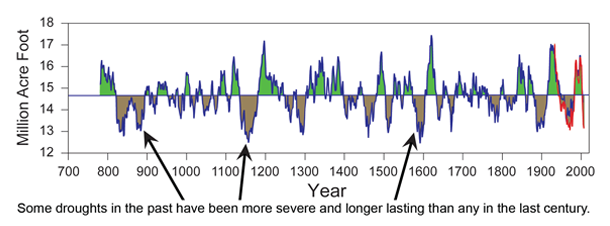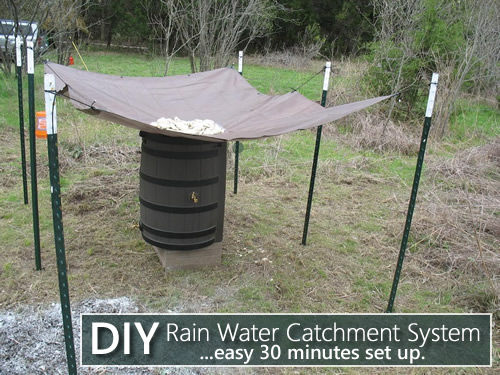Hybrid-000
Eat to Live Do Not Live to Eat
Depends on where you are. Phoenix gets 7"/year so you need a HUGE catchment and storage if you're planning to rely on rainwater alone.
DBB
DBB

Yes, this is your backup. Or for $0 investment, you can have someone haul water to you if it's a dry year. Don't need enough catchment for worst case.Just get a water trailer.
Just get a water trailer.
If the severe drought continues in the SW, the assumption that water will be available to be purchased from anyone for a reasonable cost isn't a good one IMO...... you can have someone haul water to you if it's a dry year.....








Depends on where you are. Phoenix gets 7"/year so you need a HUGE catchment and storage if you're planning to rely on rainwater alone.
DBB
Could you share a link to that chart, please?How bad do you think it would have to get before you wouldn't be able to buy water, and how rational is that scenario?

https://nca2009.globalchange.gov/southwest-drought-timeline/index.htmlCould you share a link to that chart, please?
About as bad as it is now:How bad do you think it would have to get before you wouldn't be able to buy water, and how rational is that scenario?
The drought that has enveloped southwestern North America for the past 22 years is the region’s driest megadrought—defined as a drought lasting two decades or longer — since at least the year 800, according to a new study in the journal Nature Climate Change.
https://nca2009.globalchange.gov/southwest-drought-timeline/index.html
I searched "southwest rainfall history" and posted the graphic. I guess it's actually CO river volume.

About as bad as it is now
So, it is rational to expect that water will not be available for everyone. It already is not available to everyone... depending where you live.
This looks pretty simple. The bottom of the tarp is filled with sand and pebbles to hold it in place and filters the water. Under the sand is a little hole covered in wire mesh. You could set this up in a day.
The Bureau of Reclamation is expected to declare a Tier 2 water crisis in early 2023 for users of water from the Colorado River. I think it is a bad bet to expect cities to sell bulk water to non-residents when they are increasing prices a lot and restricting water use for their residents.No... what is rational to expect is that *less* water will be available... not that you won't be able to get any, and therefore go without... die of thirst, be unable to wash, etc.
The cost of living on cheap land just went up considerably:..... Imagine a buried 2,000 gal tank.....
Great example of how cost drives usage. Keep the cost of a commodity artificially low and people will find lots of wasteful ways to use it.What water shortage?
Life hands black eyes out regardless. Risk has nothing to do with backbone. It's just math.If you are worried about what the neighbors might think, you probably want to buy elsewhere.
If you want to do your own thing and get to meet to locals, by all means, buy it. For crying out loud, take some risks, live a little people.
People are you afraid of their own shadow to take a risk these days. Time to put on your big adult pants and grow a back bone. Real life tends to hand out black eyes to the weak.
Yeah they're small but you could probably use much bigger tarps and catch more water.True, but it's also quite small. People use roofs to catch water because they are already there. But you can expand your catchment pretty cheaply. Imagine a buried 2,000 gal tank with a catchment surface that is just a packed dirt cone ~50' diameter with a waterproof membrane on top, that drains into the tank. No structure needed. A 50' dia circle will collect >1,200 gal per inch of rain.
Actually a huge part of the problem is massively increasing demand and small water users being deprioritized in favor of more profitable water buyers. In 1900 AZ had 123 thousand people. Now there are 7.1 million. NV had 42 thousand. Now there are over 3 million. NM had 195 thousand, now 2 million. Utah, 277 thousand, now over 3 million. Oh, and California... 1.5 million in 1900, and now... 39.5 million people. Thats a LOT of increase in the water needs, both for individuals and for increased agriculture, all on the same or LOWER amount of available water.The chance is of course higher than zero, but... based on this chart a major drought is a period where rainfall is 10-15% below the long term average. That isn't a lot... which is why the flora and fauna of the SW hasn't really been affected, even though we've been in a severe drought for 20 years already. The worst drought was the one in the 800s where there was ~80 year period where rainfall averaged about 92% of normal.
How bad do you think it would have to get before you wouldn't be able to buy water, and how rational is that scenario?
Enter your email address to join: